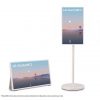Help Teens Abstain From Talking, Texting, Taking Pictures, and Going Online While Driving
As Oprah Winfrey champions tomorrow’s “No Phone Zone Day” across the country, new research from Liberty Mutual Insurance and SADD (Students Against Destructive Decisions) highlights why the message is so urgent. According to a national survey of more than 2,500 eleventh and twelfth graders, one in three (33 percent) teen drivers say they often text while they drive and 56 percent in total say they do it at least sometimes, despite nearly half (48 percent) considering it to be the most distracting behavior behind the wheel. Even more teen drivers (64 percent) say they sometimes talk on the cell phone while driving, with more than a quarter of them (28 percent) confessing they do so often.
The National Highway Safety Administration (NHTSA) reports nearly 6,000 people died and a half-million others were injured in car crashes involving a distracted driver in 2008. NHTSA also reports drivers under the age of 20 have the highest proportion of distraction-related fatal crashes.
“Six states now ban the use of handheld phones while driving, and 23 have taken an important step to ban texting while driving, yet we cannot expect law enforcement alone to eliminate these excessively dangerous behaviors by our drivers,” said Dave Melton, a driving safety expert with the Liberty Mutual Research Institute for Safety. “Because they are novice drivers, teens are more susceptible to crashes than the rest of the driving population. Combine this inexperience with an ever-growing menu of distractions that cause them to lose focus on the road and their surroundings, and you get the tragic images we’ve all seen in the news.”
Indeed, the enhanced technology and functionality of today’s cell phone brings yet more opportunities for distraction. One-quarter (26 percent) of teens admit they’ve at least sometimes used their cell phone to take pictures or videos while driving, 18 percent say they have gone online, and 15 percent say they’ve updated their Facebook or MySpace status through their phones while behind the wheel.
Ironically, of those teen drivers who admit to these transgressions, the majority admit the behavior is distracting:
Teen Behavior While Driving
| Teens Who Consider the Behavior Extremely or Very Distracting | Teens Who Consider the Behavior at Least Somewhat Distracting | |
| Text Messaging | 40% | 68% |
| Talking on a Cell Phone | 12% | 41% |
| Using Cell Phone to go to the Internet | 39% | 64% |
| Taking Pictures/Videos with a Cell Phone | 32% | 65% |
| Using Cell Phone to Update Facebook/MySpace Status | 32% | 62% |
Parents and Passengers Play a Key Role
Importantly, the Liberty Mutual/SADD study identifies a key influence on safer driving: teen passengers. An overwhelming majority of teen drivers say they would stop texting (81 percent), talking (71 percent), taking pictures or video (86 percent), or going online (87 percent) with their cell phone if a passenger requested they do so. Unfortunately, far fewer teens say they would be a passenger making such a request. For example, only 46 percent of teens say they would ask a driver to stop texting, and only 18 percent would ask the driver to stop talking on their cell phone.
The Liberty Mutual/SADD study also suggests that parents have a tremendous opportunity to enhance their role in deterring unsafe driving behaviors among teens. More than one in five teens (22 percent) say their parents have either not spoken with them about driving safety at all or have only talked with them once. Past Liberty Mutual/SADD research strongly indicates that teens who have regular conversations with their parents about driving safety are less likely to drink and drive, less likely to speed, and are more likely to wear their seat belts.
“Parents and teens can build safe driving plans together, with rewards and consequences, and our research indicates that it would prompt teens to positively change their driving habits,” says SADD Chairman Stephen Wallace. “Coupled with empowering passengers to speak up against unsafe behaviors, we can all take significant strides toward safer driving habits by all.”
About the Liberty Mutual/SADD Teen Driving Partnership
Since 1991, Liberty Mutual and SADD have collaborated on research and responsible solutions to keep families safe behind the wheel. In addition to the Family Driving Ground Rules agreement, www.LibertyMutualTeenDriving.com also features helpful resources, such as a customizable Family Ground Rules driving agreement that provides a framework for parents and teens to set and agree to specific rules around key safe driving issues such as speeding, the number of passengers in the car, cell phone usage, texting while driving and curfews.
Additional features of the site include tips on how parents and teens can openly talk about driving distractions and alcohol and drug use; video demonstrations of safe driving techniques; state-by-state teen driving laws; individual car safety scores; tips on buying and caring for a car; and an exclusive 50 percent discount for teens to take the National Safety Council’s online Defensive Driving Course.
Liberty Mutual is a national sponsor of Oprah’s “No Phone Zone” campaign to put an end to distracted driving. Friday’s “No Phone Zone” Day includes a live broadcast of “The Oprah Winfrey Show” dedicated to the issue of distracted driving, and viewing rallies in markets across the country in conjunction with leading national safety organizations, including SADD. The markets include Atlanta, Boston, Detroit, Los Angeles, and Washington, D.C. For more information, go to www.oprah.com/nophonezone.
About the Survey
Liberty Mutual and SADD commissioned ORC Guideline to conduct a qualitative and quantitative survey to measure teen driving attitudes and behaviors. The study was initiated with a series of five focus groups held in Boston, Denver and Minneapolis in April 2009. The study also involved surveying a total of 2,531 teens in eleventh and twelfth grades from 25 randomly recruited high schools across the country in the fall of 2009. These findings can be interpreted with a 95 percent confidence interval with an error margin of +/- 1.7 percent.
About Liberty Mutual Group
“Helping people live safer, more secure lives” since 1912, Boston-based Liberty Mutual Group is a diversified global insurer and fifth-largest property and casualty insurer in the U.S. based on 2008 direct written premium. Liberty Mutual Group ranks 71st on the Fortune 500 list of largest U.S. corporations, based on 2009 revenue. The company has over 45,000 employees located in more than 900 offices throughout the world.
About SADD
For more than 27 years, SADD (Students Against Destructive Decisions) has been committed to empowering young people to lead education and prevention initiatives in their schools and communities. Founded as Students Against Driving Drunk in 1981, SADD has become the nation’s preeminent peer-to-peer youth education, prevention and activism organization, with nearly 10,000 chapters in middle schools, high schools, and colleges nationwide. SADD now highlights prevention of many destructive behaviors that are harmful to young people, including underage drinking, substance abuse, risky and impaired driving, and teen violence and suicide.





























